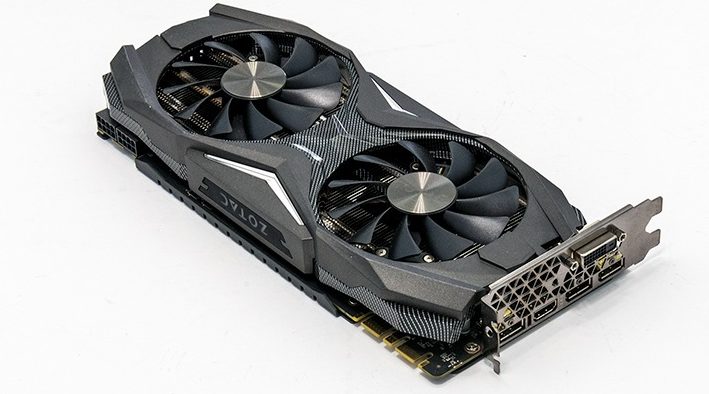




Let us first start with saying that this card is extremely potent for a 2-slot design, but it is a dual slot card. This does mean it has lower mass heatsink when compared to 2.5 or 3 slot models. There is no such thing as a free lunch, and Zotac’s engineers are limited in how much mass they can cram into a given volume. Yes they are veritable ‘wizards’ but if they were true wizards they would not be working for Zotac… they would be chilling on a beach on their own island after turning tons of lead into gold. Back here in the real world 2-slot designs are considered a compromise between ease of installation and sheer raw performance. We are stating this because it is such a good 2-slot card but is not the best of the best. So if you want so much headroom you will never even see the thermal wall… get the Zotac AMP! Extreme. Its beefier cousin does not cost all that much more but will run at near inaudible noise levels, and run cooler. It’s just physics.
With that taken care of the Zotac AMP! GeForce GTX 1070 is a wonderful 2-slot card. Its dual 100mm fans may not offer the same amount of air movement per minute as 3-fan 2-slot models, but they do move a ton of air. The heatsink is not as large as some 1070s we have looked at in the past… but the end result is pretty close. So close the only time you will notice the difference in cooling potential is when you turn all the ‘dials to eleven’. Even then it really is only when looking at 3-fan models that you will see a difference in overclocking potential.
Also on the positive side is this card is over-powered for a GTX1070. Dual 8-pin power connectors (i.e. 300 watts from the PCIe cables alone) means that even when you hit the overclocking voltage limits NVIDIA has decreed this card is no where near its max potential. This certainly will be a boon to miners as it will barely pull more than a trickle, at most, from the PCIe slot itself. Mix in a very robust for its class power delivery subsystem and even the novice overclocking enthusiast will have no problems pushing the limits of what NVIDIA is comfortable with.
In fact, as this card does not have as much cooling as some it will let you know when things are getting into the yellow zone, and then really let you know when you are in the red zone. The fans do spin up, and even by noise alone you can tell when you are within a couple percentage points of the final overclock. This makes the Zotac AMP! GTX 1070 an excellent ‘trainer’ card for novice overclocking enthusiasts. Simply stated, while it is very forgiving it will give you all the clues you need to know about when pushing things too far. Of course, the other side of this coin is it does run louder than 3-fan or 2.5slot models. The noise is actually better than say an EVGA SC and fairly similar to an EVGA FTW2 1070. That is to say it is awfully good for a 2-fan model but louder than the best of the best. Considering this card costs noticeably less than most… that is a pretty decent tradeoff.
Before we go over the final tally there is one thing worth mentioning. Zotac did make a name for themselves by offering custom overclocking profiles for their FireStorm software. These profiles basically ignore NVIDIA’s dictates and allows you to push past them. Unfortunately, this card is not one of them. Instead NVIDIA’s hard limits are in full effect. To be honest we would be a tad uncomfortable pushing this card that far… as it is a dual fan dual slot model and those extreme overlocking adventures belong… well… on an Extreme class card. It is a bit disappointing though as this card does have upwards of 375 watts of power on tap via its dual 8-pin power ports!
The other gripe concerns the VRAM, or to be more precise the lack of additional cooling potential for them. While nowhere near as bad as the EVGA ACX designs, the VRAM on a Zotac AMP! models do run a bit warmer than on some. For example, the EVGA ICX models do offer better VRAM cooling. This does limit the VRMA overclocking somewhat, but as we are conservative in our approach to overclocking the differences are not that great. Just be aware of it and make sure not push the boundaries of sanity and you will be fine… as it is not like this a bad cooling design. It just needs a few more tweaks to be perfect.
That however is about the only major gripe we have with this rather budget friendly card. As for the results we went from 1797 to 2080 MHz, and on the memory we went from an effective speed of 8008 to 8800 Mhz. Now these are conservative numbers. As we have stated many times in the past we are more interested in practical overclocking achievements rather than taking a card on a suicide run. That means our numbers are nowhere near as sexy sounding as some… but they are pretty much a guaranteed level you will hit on yours. In fact, you probably will do even better. We simply value long term stability over short term performance, and everyone has different comfort levels.











